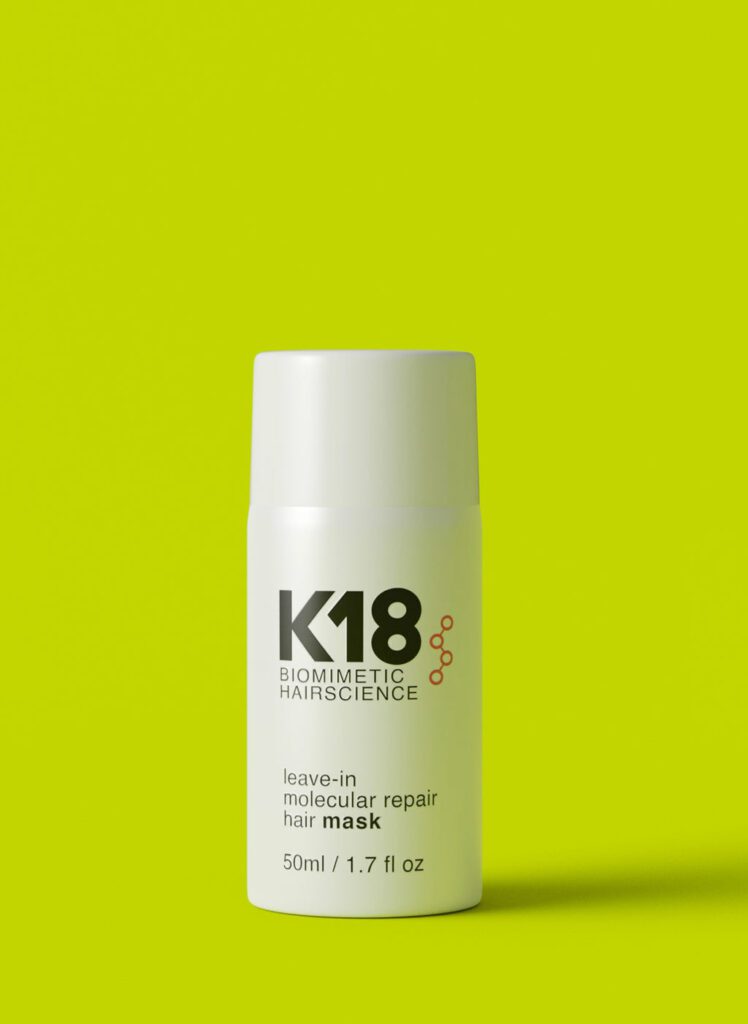
OLAPLEX vs K18, how do these compare? Many of you have heard of OLAPLEX, a brand of haircare products, designed to repair and strengthen damaged hair. OLAPLEX was developed by chemists Dr. Eric Pressly and Dr. Craig Hawker, along with Dean Christal. The brand’s first product, OLAPLEX No. 1 Bond Multiplier, was created to mitigate the damage caused to hair during chemical processes such as coloring or bleaching.
According to the manufacturer, OLAPLEX helps restore hair health, especially for individuals who have undergone chemical treatments like bleaching, coloring, perming, or heat styling. These chemical treatments break hair bonds resulting in weakened and brittle hair. For optimal results, it’s recommended to apply the treatment on the same day as the damage occurs. This is why hairstylists frequently suggest incorporating an in-salon OLAPLEX or another bond-building treatment when performing perming, relaxing, or coloring services.
The company notes that OLAPLEX can be applied within two weeks after the initial damage, though it remains unclear from the patent whether applying it beyond this timeframe will diminish its effectiveness.
Additionally, the patent states that the restored bonds can last “for at least one week…or two months or longer.” The durability and efficacy of these bonds may be influenced by factors such as the severity of the damage, the timing of the treatment application, the temperature and pH level of the water used, and even the room temperature during the product application.
OLAPLEX No. 3 Hair Perfector is a popular, pre-shampoo at-home treatment. The patented active ingredient in OLAPLEX is bis-aminopropyl diglycol dimaleate, which is designed to repair and reconnect disulfide sulfur bonds in the hair (U.S. Patent No. 9,498,419).
This video shows how OLAPLEX works vs K18.
OLAPLEX No. 1 and 2 are higher strength, salon treatments only. Users often report that OLAPLEX helps improve the overall health and strength of their hair. It can reduce breakage, increase shine, and improve the manageability of the hair.
How much does it cost?
OLAPLEX No. 3 is not cheap but much more affordable than K18. A full size bottle (100 ml or 3.3 fl oz) costs $30.
How do you use OLAPLEX No. 3?
The No. 3 Hair Perfector product is user-friendly and can be used alone or paired with OLAPLEX No. 0 for at-home repair. OLAPLEX No. 3 is not a conditioner; instead, it is designed to be rinsed out of your hair. Therefore, it is essential to follow the treatment with your regular hair-washing routine. Apply No. 3 to damp hair, before shampooing, and leave it on for about 10-15 minutes ). Then rinse it out and shampoo and condition as usual.
How quickly does OLAPLEX work?
The effectiveness of OLAPLEX as a treatment can vary depending on individual hair conditions and the specific application. OLAPLEX is designed to work in a relatively short amount of time, and its impact can often be noticed after just one use. That said, while some users may notice an improvement in the condition of their hair after just one use, the long-term benefits of OLAPLEX are more apparent with regular, consistent use for about 2-4 months.
Also, all you need is No. 3. It works just fine on its own. You do NOT need to purchase any of OLAPLEX No .4, No. 5, No. 6 and No. 7. There are equally good or better, more affordable options.
Who would NOT benefit from OLAPLEX No. 3?
If your hair is healthy and has not been chemically treated, you really do not need this treatment.

K18
Not everyone may be familiar with the new K18 product line. However, their website boasts an impressive 20+ billion TikTok views.
K18 uses patented peptide technology. See U.S. Patent Nos. 10,709,655 and 11,642,298). A peptide is a short protein. The proprietary K18 peptide is about 10 amino acids long and penetrates the hair shaft to target broken keratin chains within the hair. The amino acid sequence claimed in the patents appears to be CGPSPPCITT (SEQ ID NO:412) or GGVCGPSPPC (SEQ ID NO:409). K18 is similar to a penetrating protein treatment. According to the manufacturer, K18 reverses damage by reconnecting polypeptide chains and disulfide bonds broken during damage from bleach + color, chemical services, and heat.
As per the brand’s information, the K18 peptide sequence was discovered to possess an optimal composition of cysteines, along with the suitable structure, adjacency, and length. This allows it to seamlessly fit between the keratin chains in damaged hair. Once situated, it forms bonds with the chains and contributes to the repair of disulfide bonds.
Hair lacks the ability to self-repair because it lacks live cells capable of producing the specific keratin peptide. Therefore, K18 is presented as the “next best thing” to achieve a state of strength and elasticity that closely resembles a natural condition.
According to one paper, when applied to chemically over-bleached hair and coily hair, small peptides demonstrated the ability to penetrate the hair fiber, reaching the cortex, and binding to hair proteins. This binding led to a substantial improvement in the strength and elasticity of severely damaged hair.
These peptides also optimally repair disulfide bonds at a neutral pH. The article further emphasizes that the peptide method is considered more environmentally friendly compared to chemical treatments.
This video shows how the K18 mask works.
How much does it cost?
K18 is expensive. A full size bottle (75 ml or 1.7 fl oz) costs a whopping $75. But a little goes a long way.
How do you use K18?
Shampoo, but do not condition. Towel-dry thoroughly. Apply 1-3 pumps of the K18 Molecular Repair Hair Masque based on hair length and density, starting at the ends and working up towards the roots. Let sit for 4 minutes. Do not rinse out. Add product + style as usual.
Upon initial hair damage, the company recommends applying the K18 mask consecutively every 4-6 shampoos. Once you transition to the “maintenance” stage, it is suggested to use the mask every 3-4 washes to provide ongoing protection against daily damage.
How quickly does K18 work?
K18 is often praised for its ability to deliver noticeable results in a relatively short amount of time, and after a single-step treatment with the K18 Molecular Repair Hair Masque. Users say their hair is left feeling thicker, softer and silkier with just one use. While K18 is known for its quick results, its long-term benefits can also be observed with consistent use.
Who would NOT benefit from K18?
If your hair is healthy and has not been chemically treated, you do not need this treatment. And if your hair is coarse, this treatment can lead to protein overload.
How do OLAPLEX and K18 compare?
Here’s a comparison table highlighting key features of OLAPLEX vs K18 Molecular Repair Hair Mask:
| Feature | Olaplex No. 3 | K18 Molecular Repair Hair Mask |
|---|---|---|
| Key ingredient | Bis-Aminopropyl Diglycol Dimaleate | K18Peptide™ |
| Purpose | Strengthens and repairs hair bonds | Repairs damaged hair at the molecular level |
| Application | Salon and at-home treatment | At-home treatment |
| Recommended Use | Once a week or as needed | Every 4–7 days (or as needed) |
| Application Time | Minimum 10 minutes | Approximately 4 minutes |
| Compatibility | Compatible with most hair types and chemical processes | Compatible with chemical processes; suitable for all hair types |
| Visible Results | Improved texture, reduced breakage, increased shine – 4 months | Quick and visible improvement in strength and elasticity – immediate |
| Long-Term Benefits | Regular use to maintain and strengthen hair | Regular use for ongoing maintenance of hair health |
| Cruelty-Free | Yes | Yes |
| Sulfate-Free | Yes | Yes |
| At-Home/Professional Use | Both at-home and professional use | Both at-home and professional use |
| Price Range (Approximate) | $$ | $$$$ |
We hope this post answered all your questions about Olaplex vs K18.
Don’t know your hair characteristics? Take our HAIR QUIZ.
If you have hair or product-related questions, get them answered in our private Facebook group – join HERE.






